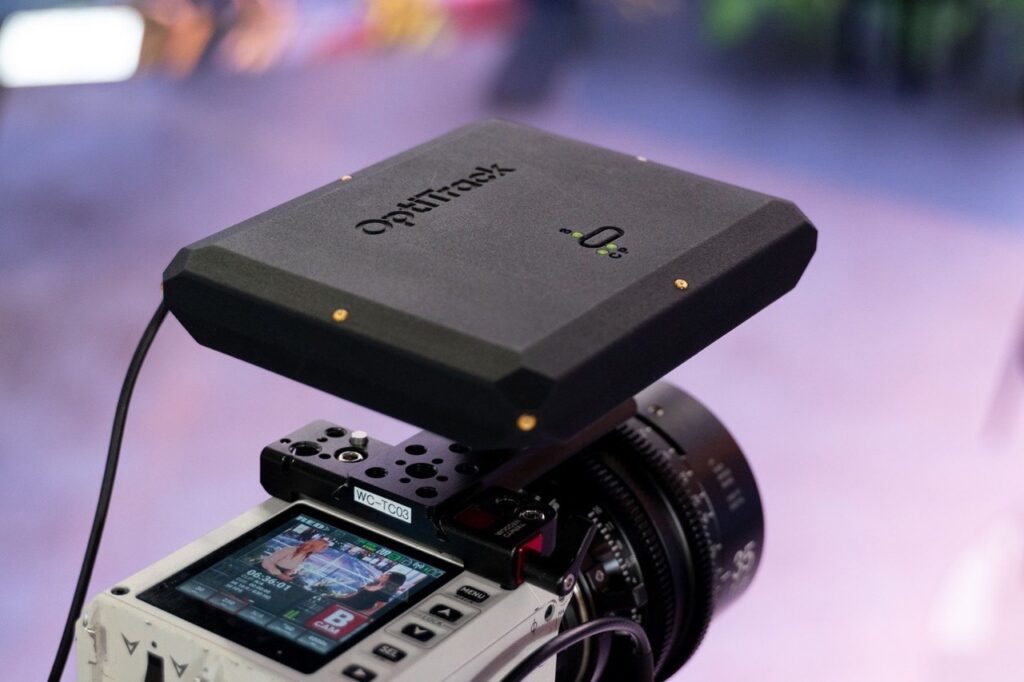The device, for advanced camera tracking on an LED stage, is purpose-built and provides the accuracy necessary for real-time settings.

3D tracking systems provider OptiTrack has released a new tracking tool, called CinePuck, created specifically for real-time environments such as virtual production, mixed reality, and broadcast stages. CinePuck is small in size yet provides the precision and accuracy required for this kind of live tracking, thanks to an all-new inertial measurement unit (IMU).
Unlike many of the tracking technology applications in use today that have been repurposed from other applications, CinePuck was designed for virtual production and developed using input from cinematographers who shoot on LED stages. As a result, CinePuck is super compact and lightweight, and comes with several mounting options. This means cinematographers can secure it to their camera/rig of choice, even complex and large ones, and it will remain fixed and steady, and thus able to withstand vibrations that would otherwise compromise it.
CinePuck uses OptiTrack Active technology, which features LEDs that uniquely identify themselves to allow hundreds of identical objects in a scene. CinePuck features an industrial-grade IMU and ultra-bright wide-angle LEDs for high-quality, smooth tracking. LEDs in the CinePuck send infrared pulses to the OptiTrack cameras, and Motive software precisely determines the camera’s position in the volume. Pin-point accuracy is maintained even when occlusion occurs: All but one marker can be occluded and users can still achieve full six degrees of freedom (6DoF) tracking. This results in the capture of cleaner data and requires less postproduction.
The device can be seamlessly integrated into any production workflow, even those with crowded rigging configurations, using a variety of mounts, such as an ARRI Anti-Twist mount, so any camera can be used. CinePuck also features an embedded antenna for improved wireless range, a battery that lasts more than 14 hours, and a durable enclosure for rigorous workflows.
CinePuck is also affordable. According to Neil Abrew, OptiTrack brand manager, users can achieve full-volume tracking in a 30 × 30-foot space for approximately $30,000 in total. That cost is for the recommended system to optimize capture in that specified volume from edge to edge, including the CinePuck ($2,999), 12 SlimX13 cameras ($1,699 each), and Motive software ($999 for Tracker), as well as cabling.
Orbital Virtual Studios was an early beta tester. Leonidas Jaramillo, Orbital’s in-house cinematographer, pointed out that many other facilities use work-arounds in their projects because virtual production is still so new. “You don’t necessarily see the finished product while shooting live. Using CinePuck in our workflow at Orbital allows us to take advantage of our optimized 3D environments, enabling us to capture final pixel in camera and see it unfold in real time,” he added. “There are so many elements of virtual production technology that need constant attention during shoots, it’s comforting to know we don’t have to worry about occlusions, markers falling off the ceiling, or adding unnecessary weight to Technocrane/Steadicam/Trinity rigs. Instead, we can focus on capturing amazing visuals in real time.”
For the past few years, OptiTrack has been building on its puck technology, which was initially targeted at location-based entertainment centers. A further streamlined version, the Active Puck Mini, followed, eliminating the need for a full mocap suit, requiring only six makers to be attached to specific areas of the body (wrists, feet, a ball cap, and belt).





